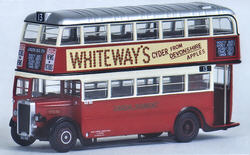
|
THE REAL BUSES London Transport placed an order for 100 double deck buses with Leyland in 1937, the vehicles STD1-100 had metal bodies that were similar to those specified for the earlier STL class despite this there were still a number of subtle differences which included a small window on the rear off-side in the stairwell and a more curved lower edge to the driver windscreen. The STD code is thought to have come from a combination of S from STL and TD from the Leyland Titan TD4 type. Other reports also suggest it may stand for "Short Type Diesel". The first 90 vehicles had the standard Leyland 8.6 litre oil engine and clash 4 speed constant mesh gearbox the remaining 10 had a Lysholm-Smith torque converter. This variation allowed comparison of the two transmissions systems which resulted in the clash box being deemed the superior and leading to the other 10 eventually being converted to match their sisters. |
|
The vehicles spent most of their working life on routes operated by Hendon (AE) garage and were easily identified by the distinctive deep throb of their engines. During the war years a number of vehicles were dispatched to the country area to replace Green Line coaches that had been converted into ambulances, however they didn't find favour and were soon returned to the central area where some were eventually allocated to Cricklewood garage. After the war all the STD's returned to Hendon, their original livery of red with white window surrounds and silver roof was replaced by the new style livery of red with cream upper deck windows, in their final years in service this was further simplified to all red with just a cream between decks band. In 1951 Hendon received new RTL's for its route 13 allocation leading to some of its STD being reallocated to Enfield (E) depot where they replaced war time G class utilities. The class remained in passenger service at both Enfield and Hendon until 1954, a few examples survived as trainers until 1955 . On withdrawal some went to other operators and contractors for further service while others were completely scrapped or had the original bodies replaced with truck ones for use in LT ancillary fleet. Sadly none of the vehicles have survived into preservation. The STD class was expanded with additional members during and after the war. 11 examples (STD101-111) based on the TD7 chassis were acquired with utility Park Royal bodies in 1942 and after the war in 1946 a further 65 (STD112-176) almost standard Leyland Titan PD1 vehicles were bought as a tamporary measure to cover a vehicle shortage that existed before delivery of the new RT's got underway in 1947. The post war vehicles have already been modeled by EFE and form the 202 series. THE EFE MODEL This model appears to use the same casting as the existing roof box STL and has been combined with a new Leyland radiator. The first release of the model was at the 2007 EFE Showbus International Rally. Although the class only operated around 15 routes in the capital they carried at least four different London livery variations so there should be plenty of scope for future releases. |
|
| Cat No. | Operator | Fleet No. | Registration | Route No. | Destination | Released |
| 33601 | London Transport - Red (Produced for the 2007 Showbus Rally & also available from the London Transport Museum) |
STD 38 | DLU 348 | 13 | London Bdg Stn | Sep 2007 |
| 33601A | London Transport - Red (Produced for the London Transport Museum) |
STD 14 | DLU 324 | 3A | Crystal Palace | Nov 2007 |
| 33601B | London Transport - Red (Produced for the Cobham Bus Museum) |
STD 64 | DLU 374 | 83A | Golders Green Stn | Apr 2008 |